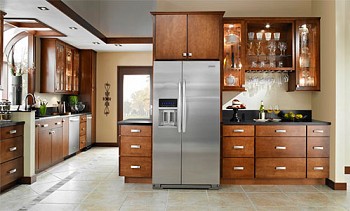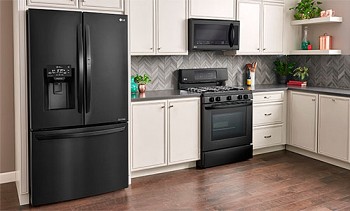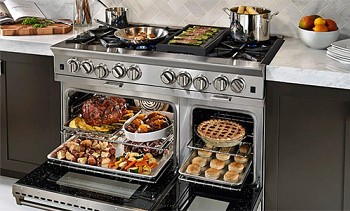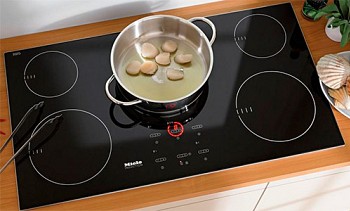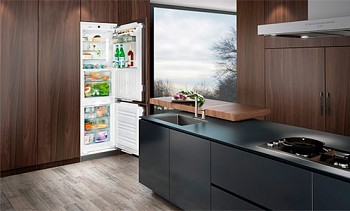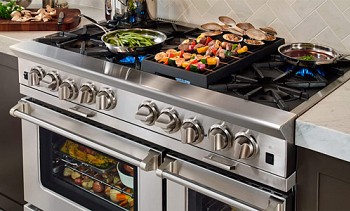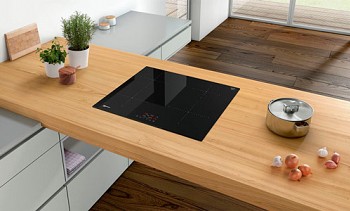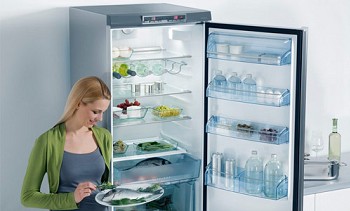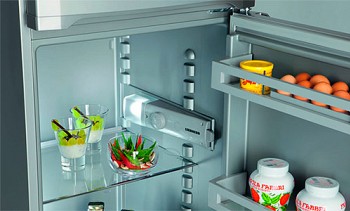Recently, hobs are becoming more common, displacing gas and electric stoves. They are divided into induction and electric, although they all work from a 220 V household network, and it would be more correct to classify them into induction and non-induction.
To find out which is better, an induction hob or an electric one (without induction), we consider a device of each type, the principle of operation and advantages with disadvantages. This will help to see the pros for specific operating conditions and be ready for the cons, and also will not let you regret your choice in the future.
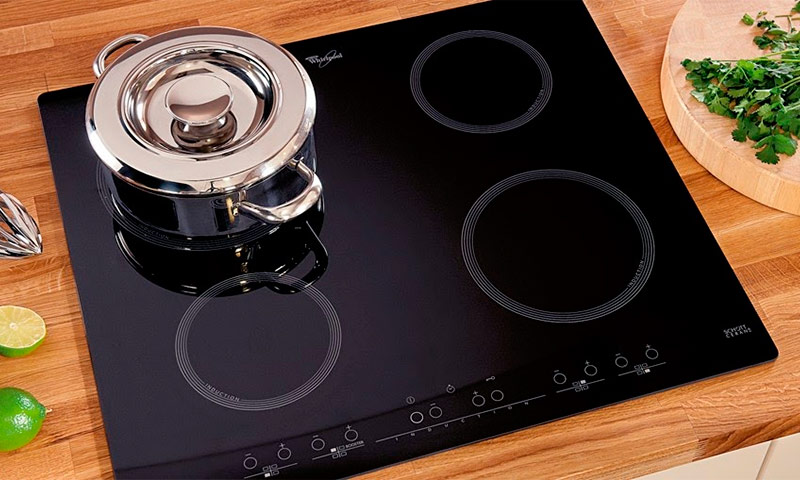
Content:
What is the difference between induction and electric non-induction hobs
Induction cooking hobs have appeared relatively recently. In contrast, electric (conventional) stoves have been around for decades. To increase the comfort of their use and increase the level of sales, manufacturers have developed several separate types, each of which has its own characteristics. Let's take a closer look at them.
Device difference
First of all, this type of kitchen equipment differs in design. This includes both internal parts and external performance. The functionality of the devices, their dimensions and price depend on this.
Cast Iron Cooktops
This is one of the oldest types of kitchen equipment. They were called electric stoves and used at the dacha or at work for heating water and cooking.
The equipment consists of:
- The heating element is in the form of a spiral. It is made of an alloy of nickel and chromium, which makes it resistant to high temperatures and allows you to maintain its properties despite many heating and cooling cycles. The spiral is wound with a snake or in a circle and is separated from the outer surface by a layer of heat-resistant insulation.
- From above it is covered by a massive cast-iron disk, on which the dishes are installed.
- A mandatory element of such a device is a temperature controller for setting the temperature.
- To control the unit from the outside, a switch is displayed.
- Typically, the housing is equipped with a light diode to inform about the connection to the network.

Cast iron hob.
The number of cast iron burners can vary from 1 to 4 and vary in diameter and power. The rest of the casing is enameled, less often it is made of stainless steel. Thanks to simple components, the price of such a hob is low.
Hob type High Light
The device of such a hob includes a heating element in the form of a tape. Most often it is stacked in a circle. Such tapes are made from semiconductors. The technology allows placing the heating element under cast-iron “pancakes”, but to increase the aesthetic appearance, manufacturers began to use a glass-ceramic surface. Through a transparent plate, light from a heated element is better visible, therefore, the risk of accidental contact and burns is reduced.
By configuration, the panel can contain from 2 to 4 heating zones, varying in diameter. Most often they are equipped with touch control. The cost of kitchen appliances Higt Light is much higher than the "classic" with a spiral, but remains quite affordable.

Hob High Light.
Halogen hobs
A hob with halogen technology consists of hobs, inside of which two heating elements are integrated: thermal and infrared. For this, the manufacturers endowed it with a spiral made of a semiconductor laid in the shape of a snail. A lamp is laid across it, which is a glass tube with a halogen and its own filament.
The device is complemented by a thermostat and controls. The number of burners is from 1 to 4. They are covered by glass ceramics. Price in the same segment as Higt Light, where more value is influenced by the equipment of additional functions.

Halogen hob.
Induction panels
Induction panels are fundamentally different in design from all others. The outer part is made in the form of a glass-ceramic coating, and a transformer is located inside. The latter is a flat winding induction coil. It is separated from glass ceramic by an insulation layer. The electronic control unit controls the voltage level.
A temperature sensor and ferrite inserts are integrated inside the coil. Some models use a fan to further cool the element. From 1 to 4 burners of different diameters can be located in one casing of the device. The cost of panels of this type is much higher than others.

Induction hob.
The difference in the principle of action
To figure out which hob to choose, electric or induction, a short comparison of their operating principles, reflecting the efficiency of heat transfer, will help. Here's how this happens for each species:
Cast iron
The current passes through a twisted spiral and heats it to a temperature of 400 degrees. Then the heat is transferred to the cast-iron disk, from it to the metal pan, then to the food inside. Thanks to the thick layer of cast iron, the heat is distributed evenly and continues to act for a long time after shutdown. The burners are divided by power, which is convenient for cooking large and small volumes, and also affects the time of boiling water.
High light
The principle of operation of the hob is similar to the above, but the tape, unlike the spiral, allows you to position it more tightly, which increases the amount of heat transfer area and the speed of the process increases. A semiconductor tape shines through a glass surface, and this is important for safety.
In one burner, several belts can be connected via parallel connection, which turns the burner into a whole zone, the diameter of which can be narrowed or expanded depending on the dishes being installed and the inclusion of a certain number of belts. Heat passes the same steps: from tape to glass ceramics, then to dishes and food.
Halogen
Here, the principle of operation is based on the rapid heating of a lamp with a halogen and a conductive thread. This design emits both heat and infrared rays at the same time, so the food heats up much faster. After reaching the desired temperature, the lamp turns off and the process is supported by a conventional electric spiral. Such panels work faster due to double exposure, but heat passes the same obstacles (panel, bottom of the pan).
Induction
The principle of operation is sometimes called cold. This is due to the lack of heat generation inside the hob and its transfer to the dishes, and immediately the generation of food heating. A flat coil of a transformer passes an electric current through itself and forms an electromagnetic field. This leads to the formation of eddy currents.
A pan made of a ferromagnetic alloy serves as a counterpart to the transformer and participates in electromagnetic induction. Thanks to this, the food heats up, and the glass-ceramic panel and dishes do not serve as intermediate links in the transfer of heat.

The principle of heating products by induction hob.
Power consumption
Cast iron hobs can have different capacities. One burner can consume from 0.7 to 1.5 kW per hour.If the appliance is equipped with three burners with a power of 1, 1.5 and 1.75 kW, and they are turned on simultaneously at full power, then such an electric hob will consume 4.25 kW.
This is one of the most uneconomic types of household appliances in the kitchen, due to the long heating and high energy consumption. In a month, with daily cooking and heating of food, up to 60 kW can be spent per person.
Halogen and Higt Light panels are powered by a 220 V network and the power of one burner varies from 0.8 to 2.3 kW, depending on the number of simultaneously connected strips, to create a heating zone. Some models provide a double heating field with an expanded area, which is endowed with a power of 1.5-2.4 kW.
In terms of the amount of electricity consumed, they can exceed cast iron, but due to the rapid transfer of heat from the heating element and a higher temperature, the cooking time is reduced, so the device works less and, therefore, is more economical. About 50 kW per month will be spent per person.
Induction hobs have a power of each burner from 1.4 to 2.2 kW. Particularly large heating zones with the possibility of expansion are equipped with transformers consuming up to 3.1-3.7 kW per hour. But in view of the direct transfer of heat to the products in the container, bypassing the glass ceramics and the bottom of the dishes, this energy is spent directly on heating the food, so the operating time is even less than that of non-induction cookers.
At the same time, it is not necessary to turn on the device at maximum power, because heat does not need to heat several barriers in its path.
According to general estimates, the use of induction panels reduces energy consumption by up to 30% compared to other types.
Heating rate
An important factor when choosing a hob is the heating speed, which affects the cooking time and how much the hostess will have to stand at the stove. Compared to conventional electric panels, induction units operate twice as fast.
During the experiments, water was boiled in the same capacity and on models with the same power. Thanks to the exact "targeted" heat delivery to water, the boiling time is halved.
When you turn on the halogen and Higt Light tiles, the burner is ready after 4-6 seconds (very hot state). In induction models, this indicator is 2 s. The efficiency of panels with transformers reaches 90-93%, while for cast-iron “pancakes” the value drops to 53%.
Inertia
The concept means the time that heat is retained after the device is turned off. Long cooling of the surface, on the one hand, is a useful feature, since it allows you to cook on the hot burner after turning off the power supply for some more time without consuming electricity.
But if the dish is overheated (water boils over the edge, food burns strongly in the pan), then even turning off the appliance does not immediately change (due to the preservation of heat in the components of the structure), so low inertia is appreciated in the kitchen.
In this regard, cast-iron panels lose much, where thick metal gives off heat for a long time. Halogen and Higt Light, due to the spirals acting on glass ceramics, also cool for a long time.
Induction panels also win here because they heat the food itself and quickly respond to changes in settings. The surface is heated only as a result, from dishes that transfer heat from food inside. If something burns, then you can remove the excess temperature with one touch.
Safety of use
All types of non-induction models have a temperature on the surface of the burner about 500 degrees. An accidental touch promises a burn. Thanks to glass ceramics, you can see that the burner is hot, which serves as a warning to users.
But if the cooking is finished and the appliance is disconnected from the power supply, the danger zone is not highlighted (there may be a warning indication elsewhere) and the unknowing person is able to put something on it or touch it with his hand.Possible ignition of objects on the freshly turned off burner.
In induction hobs, the glass surface is heated from dishes with hot food, and not from a heating element, so its temperature is about 80 degrees. Although it is not worthwhile to touch the working device intentionally, but an accidental similar action will not cause serious harm.

Remove milk from the induction hob without waiting for the end of cooking.
Even if foreign objects get on the burner included, ignition is excluded (heating only materials with a ferroalloy does not affect other substances).
Cooking comfort
There is no clear leader in terms of comfort, since besides cast-iron models, all the others have touch control, fine-tuning and various functions. Indicators are built into all types of hobs to help determine the current temperature and set its subsequent value.
Induction hobs, due to their functionality, have some advantages over non-induction models.
Cookware Requirements
For non-induction types of cooking surfaces, the main requirement for dishes is the presence of a flat bottom. If the kitchen container has a raised bottom, then the heat transfer from the burner to the dishes will also pass through the air (in those parts that do not touch the surface).
As for the material for making dishes, there are no restrictions here, that is, it can be prepared in all types of dishes: copper, aluminum, fire-resistant glass.
Induction tiles have their own limitation - they interact only with dishes, where there is a ferromagnetic alloy. This can be checked by attaching a magnet to the bottom of the tank. Adhesive - then it’s suitable. Therefore, aluminum, copper and glass containers automatically disappear.

Cookware for induction hobs is indicated by a special sign, which you can see in the photo above.
Pans with a multi-layered bottom, where magnetic stainless steel is outside, will do, but they will make unpleasant sounds. If you put a metal object with a ferroalloy on such a surface, but not dishes (a spoon, a coin), the panel will start to peep and will not turn on. By configuration of the bottom, any options are allowed.
Each type of hobs has its own limitations on the use of cookware, however induction hobs have more requirements.
Additional features
Electric stoves with cast-iron hobs are equipped with a temperature controller. The best representatives of this segment may have a timer that helps to time the cooking time. The rest are simple kitchen appliances.
Models with halogen technology and Higt Light have gone a long way.
Among their equipment may be present:
- Possibilities for expanding the cooking zone by 2 or 3 rings.
- Residual heat indicator. It works when the burner is started and shows what temperature it has during the whole process. When the tile is turned off, it continues to burn until the temperature becomes safe. This can be used for short heating (water, dough approach, etc.).
- Boiling sensor. Automatically monitors the temperature and maintains the boiling of the dish, but so that it does not go over the edge of the dishes.
- Auto power off. If you do not perform any actions in the settings, then after a certain amount of time the panel will turn itself off. This is practical when a person put down the kettle and fell asleep or he was urgently called and he forgot about food on the stove.
- Child protection. Blocks any interference with settings. Children will not be able to turn on, turn off the device or change the existing mode.
- Timer. It is carried out in two options. The first simply counts the cooking time set by the user and gives a sound signal. The second independently turns off the equipment after the set value.
- Sensor Slider You can set the temperature according to the drawn scale, working on sensor technology.No need to repeatedly click on the “+” to add degrees, just swipe your finger up to the desired level.
But all these functions are also in induction hobs.
In addition, this type of equipment can be supplemented with the following features:
- Pause. If the courier or someone else distracted the hostess from cooking, then pressing the “Pause” button will stop the heating, and pressing it again will return all settings and allow you to continue from where the process was interrupted. Food will not burn and boil.
- Binding to other equipment. The latest models of inductive hobs can be combined using the technology of "smart home" with other devices. For example, the stove can be configured to simultaneously start with a hood. The latter can still continue automatic operation for 10-15 minutes after turning off the burner to remove excess odors.
- Recognition of dishes. Only induction models are able to determine what is on top and not turn on if it is not dishes. This feature increases protection against fire or damage to accidentally forgotten objects (cutting board, plastic skimmer, etc.).
- Display. In recent generations, a TFT-screen is built in, on which the entered settings are clearly displayed. This simplifies the cooking process and makes it more interesting.
- Intense heating. The function gives increased voltage at start-up to bring the water to a boil as soon as possible, after which it goes into normal heating mode. This saves a lot of cooking time.
Easy care
Electric cookers with cast-iron burners are easy to care for - the enameled or stainless surface is easily cleaned from drops of fat or sweet syrups. But if the food got on the next heated ring, then it will burn and remove such a trace will be more difficult.
Electric halogen and Higt Light models have the same problem - spray on the cold part is easily washed off with the means intended for this, and those that get on the cooling zone burn.
Induction hobs do not have hot spots, so they will never have traces of burnt milk or cereal. But glass ceramics are sensitive to sweet syrups that leave whitish marks on the surface.
This is due to the penetration of such substances into the pores of glass ceramics. But since other types of electric stoves are equipped with surfaces from this material, induction stoves are distinguished by simpler maintenance.
Comparison table for induction and electric non-induction hobs
 |  | |||||||
|---|---|---|---|---|---|---|---|---|
| Electric induction hobs | Electric non-induction hobs | |||||||
| Power consumption | 30% less | tall | ||||||
| Heating rate | high | low or medium | ||||||
| Inertia | high | low | ||||||
| Safety of use | outer surface does not heat up | outer surface subject to extreme heat | ||||||
| Cooking comfort | high, but there are advantages | tall | ||||||
| Cookware Requirements | ferromagnetic alloy cookware required | no special requirements | ||||||
| Additional features | represented in large numbers | less than induction models | ||||||
| Easy care | very simple | plain | ||||||
Alternative - use of combined cooktops
Today, more and more buyers understand the advantages of induction panels, but do not dare to completely switch from traditional electrical types. Others, having weighed all the pros and cons, can not decide. For such users, manufacturers produce combined models containing two burners with induction coils and two or one Higt Light.

Combined hob.
This allows you to quickly cook on induction hobs, saving electricity, and at the same time use the energy of residual heat Higt Light for other processes. The hybrid allows you to combine different types of dishes (aluminum and stainless, glass and copper).
But the cost of combined models is now higher than individual representatives of a certain category, which also needs to be considered when choosing.Taking into account the above tips, you will be able to make a competent purchase, facilitating everyday work in the kitchen.

